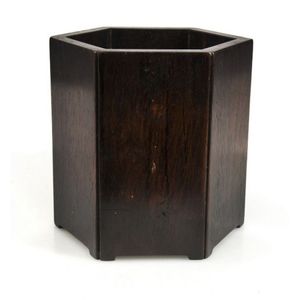Georgian Ale Glasses and Air Twist with Opaque Stems
You must be a subscriber, and be logged in to view price and dealer details.
Subscribe Now to view actual auction price for this item
When you subscribe, you have the option of setting the currency in which to display prices to $Au, $US, $NZ or Stg.
- Twist - A rod of glass in which there is one or several threads or tapes of coloured glass, or bubbles of air embedded, which is then twisted to give an attractive appearance. The technique is mostly associated with the stems of Georgian glasses. The technique was in use from about the 1740s to the 1760s.
Collectors have identified over 150 variations of twist decoration. One of the most common is the air twist which as the name implies, has one or more columns of air embedded within the rod. A colour twist has one or more coloured tapes, usually opaque but sometimes translucent. other common types of twist include cable, corkscrew, enamel, gauze, lace, opaque and thread. - Georgian - As an English stylistic period, Georgian is usually taken to cover the period from George I (1714) to the Regency of Prince George (1811-20), although the period from 1800 to 1830 is sometimes designated as the Regency period. During the Georgian period the great English cabinetmakers and designers such as Chippendale, Hepplewhite, Adam Sheraton etc., were all active.
Therefore there isn't a single 'Georgian style' as such and to say something is 'Georgian', usually means it was made between 1714 and 1830. This assumes we discount George V and George VI, both being from the 20th century.
The styles popular at the time of each reign were:
George I (1714-1727) saw out the last years of the Baroque period.
George II (1727-1760) reigned during the Rococo period.
George III (1760-1820) saw the last gasp of the Rococo, all of the early Neo-Classic 'Adam style' and most of the later neo-Classic 'Regency style'.
George IV (Prince Regent 1820-1830)encompassed the last of the 'Regency' style.
William IV's reign (1830-1837) was something of a no man's land (stylistically) and he wasn't a 'George' anyway. He covered the last glimmerings of 'Regency' and the start of the 'Victorian' style. - Air Twist - An air twist is a decorative feature found on some types of glassware, including Georgian drinking glasses. It is created by twisting the glass while it is being blown, which creates a spiral pattern of ridges or rings around the stem of the glass. The air twist is typically made by a skilled glassblower using a hot glass rod to shape the glass. It is a decorative feature that adds visual interest to the glass. Georgian glassware is known for its high quality and intricate design, and the air twist is just one of the many decorative elements that may be found on Georgian drinking glasses.
This item has been included into following indexes:
Visually similar items

An Art Deco style silver and stone set ring, floral cluster set with zirconias and synthetic rubies. Size N

Lovelock, Gloria Alice (1906-1995) blue and white slab Built coffee pot, 1933. Stylised floral motifs. Signed and dated. Small internal chip to spout. Height 19 cm

Chinese hexagonal wooden brush pot. Use patina. Provenance: Australian collector. Height 18 cm. Diameter 18 cm

A Greek Hellenistic pottery cup with high rising loop handle, 2nd/1st century BC, 13 cm high
